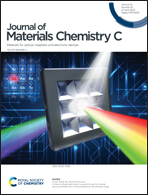Surface ligand engineering involving fluorophenethyl ammonium for stable and strong emission CsPbBr3 quantum dots and high-performance QLEDs†
Abstract
All-inorganic CsPbBr3 perovskite quantum dots (CsPbBr3 QDs) have become one of the most promising materials in the field of optoelectronics. However, the poor stability and low photoluminescence quantum yield (PLQY) of CsPbBr3 QDs hinder their further applications. Herein, fluorinated aromatic ammonium bromide (fluorophenethyl ammonium bromide, FPEABr) is introduced in the synthesis of CsPbBr3 QDs. The influence of the fluorination position (ortho, meta, and para) at the benzene ring on the optical properties and stability of CsPbBr3 is systematically evaluated. The results indicate that the short fluorinated aromatic alkyl ammonium chain has been successfully adsorbed onto the surface of CsPbBr3 QDs, and the bromine vacancy defects have been significantly reduced. Eventually, stable CsPbBr3 QDs with a high PLQY (>90%) are achieved with the use of pFPEABr. Furthermore, the short chains of the ligand improved the carrier transport in the CsPbBr3 QD film, and thus the surface treatment increases the maximum luminance of the corresponding perovskite quantum dot light-emitting diodes (QLEDs) from 531 to 1278 cd m−2. The surface ligand engineering strategy involving the FPEABr ligand, in particular pFPEABr, actually provides a new direction for the future development of high-performance QLEDs.



 Please wait while we load your content...
Please wait while we load your content...